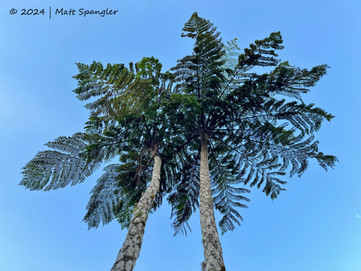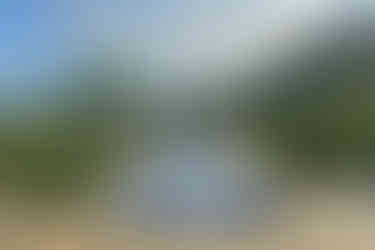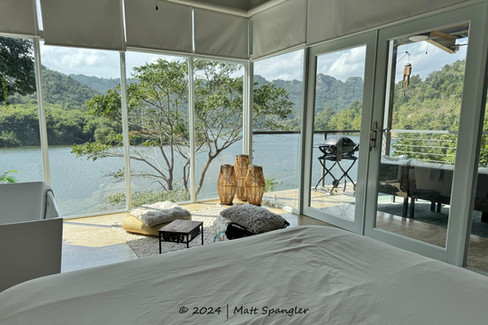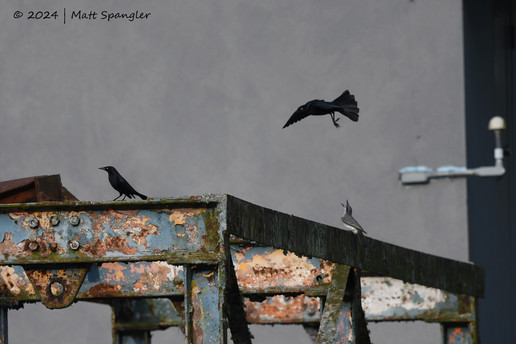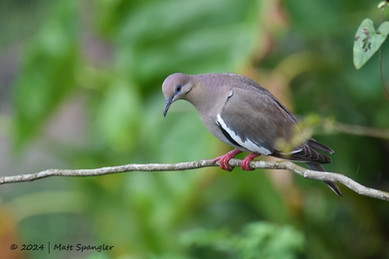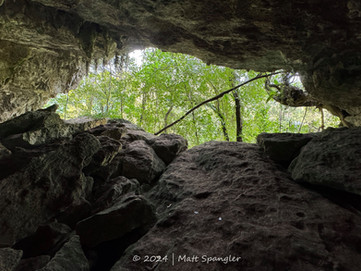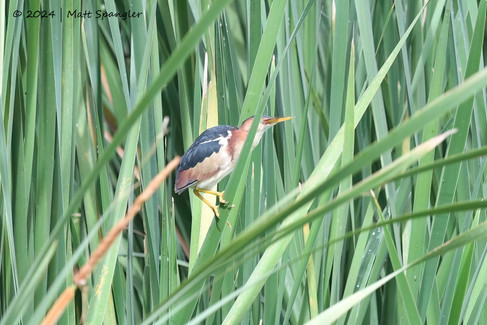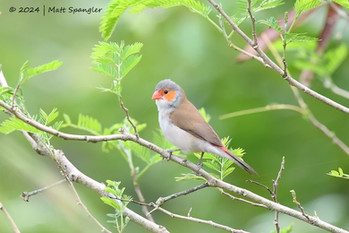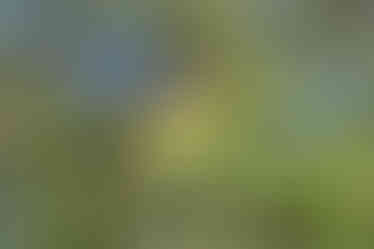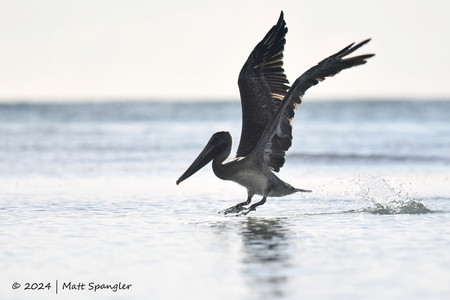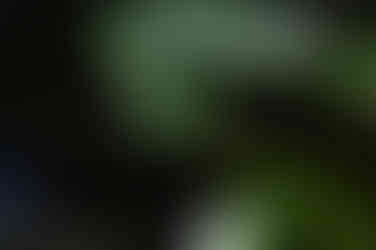My wife and I needed to escape the cold drudgery of February in North Carolina, so we headed down to Puerto Rico. Escape the cold we did—the tropical temps ranged from the 60s to upper 70s or low 80s every day. The trip was a bit cloudy and rainy, but that made us really appreciate the sunny periods.
This was our first trip to the island, and it won’t be our last. So, what did we do? Well, no surprise, but we didn’t do the “normal” stuff, like drinking mojitos on a resort-front beach. Instead, we covered a lot of ground exploring the island from top to bottom. We hung out in San Juan for several hours on the front and back end of the trip, but we spent most of our time bouncing between Airbnbs in the island’s rural, mountainous interior. I stayed a couple days longer than my wife, giving me a chance to explore the dry forests and cliffs of the southern coast. This gave the trip an interesting cadence: transit day, full day, transit day, full day, transit day, full day, transit day.
I observed a ton of wildlife, including all 18 bird species endemic to Puerto Rico (i.e., found nowhere else on Earth). Finding those species created an extra incentive to check out all the different major habitat types on the island. Next time, we’ll probably hunker down more and enjoy just one or two areas. Possible next-time attractions include Old San Juan, El Yunque National Forest, and Vieques. But this blog is about this time.

Saturday
We flew into San Juan mid-day, picked up a rental car, got groceries at a Condado co-op, and then headed south out of town to our first rural retreat. The rainy drive provided a good introduction to the slow, curvy Puerto Rican mountain roads and traffic. The home stretch up to our Airbnb in Barranquitas/Cañabon was a rollercoaster; the road grew so steep it felt like our car would fall backwards into space. That’s why they recommend check-in before dark!
Our Airbnb (“Rural Magnolia”) was sleek and modern, with an incredible view of the surrounding mountains and countryside. The area was an interesting mosaic of lush mountainsides and creeks, productive and unproductive agricultural areas, and regularly scattered houses and windy roads. This was the authentic inland Puerto Rico experience.
Our property had several captivating tree ferns. There are apparently at least 14 different types of tree ferns in Puerto Rico, and I’m not fit to identify them. The point is, it’s a fern, but tree-size, towering 20+ feet in the air. I find tree-sized non-woody plants fascinating. Palms and tree-size grasses (bamboo) are weird enough, but to see a tree-size fern really blew my mind.
But this blog is about wildlife, right? The wet weather and approach of nightfall instigated a chorus of Common Coquis—one of Puerto Rico’s famous animal mascots. These vocal, endemic treefrogs were calling from everywhere, and we got good looks at a dozen singing from various places around the house.
Later in the night, we were also treated to the sound of a neighbor’s music. Somehow, I was able to hear the repeated calls of a Puerto Rican Owl over the tunes! This was basically my first bird of the trip, and a good one—a lifer, endemic to Puerto Rico (endemic # 1; the count begins).
Sunday
Our first full day on the island began like most vacations: I went out exploring while my wife slept in and relaxed. I spent a couple hours getting acclimated to our immediate surroundings. First was a drive to La Torrecilla, the highest peak in the immediate area, at 3058 feet above sea level. It was extremely foggy, and I couldn’t see much of anything. But I did manage to see 6 new birds: the ubiquitous Bananaquit, the similarly common Scaly-naped Pigeon, Zenaida Dove, Pearly-eyed Thrasher, Black-faced Grassquit, and Yellow-faced Grassquit.
After driving back to the house, I went for a longer walk around the local roads. This yielded 10 more lifers: Gray Kingbird (omnipresent in PR), Shiny Cowbird, Greater Antillean Grackle, Caribbean Martin, Orange-cheeked Waxbill (a species from Africa, naturalized here), Puerto Rican Oriole (endemic # 2), Puerto Rican Bullfinch (heard-only for now, but endemic # 3), Puerto Rican Woodpecker (endemic # 4), Puerto Rican Emerald (a charming hummingbird, endemic # 5), and Red-legged Thrush. Cool non-lifers, uncommon to me but common here, included lots of White-winged Doves and a Smooth-billed Ani.
Back at the house, I saw a handful of lizards. There are a dozen different species of anoles on the island, but I think all the ones here were Crested Anoles, a common but highly variable species. I also found a Cuban Leaf Slug.
We ventured out for our first joint adventure later in the morning. A 15 minute drive south brought us to Finca Don Felix, an estate-turned-nature reserve with nice trails. The main trail culminated in a view overlooking the Cañón San Cristóbal. Wildlife highlights included one more bird lifer (Loggerhead Kingbird) and a few American Kestrels. I also found a Banded Anole (lifer lizard). During a momentary burst of sunshine, I saw a handful of butterflies, including a Southern Red Rim (lifer) and a Julia Heliconian.
After an underwhelming lunch out, we spent the rest of the afternoon at the house. The overcast skies eventually broke, gracing us with a few hours of sunshine and beautiful views, plus more photo-ops of my favorite tree ferns.
I realized I could hike to the top of the nearest mountain (La Torrecilla) straight from our Airbnb, along some dirt roads. After a short but steep 300-foot ascent, I was more or less at same spot I’d spent 10 minutes driving to earlier in the morning. Once at the top, I had excellent views of the mountain valley, extending all the way to San Juan and the Atlantic Ocean. There wasn’t much wildlife atop the hill (midday siesta), but I saw one new butterfly: a Puerto Rican Calisto.
The relaxing evening featured another Puerto Rican Owl (who didn’t have to compete with any music tonight, thankfully) and another deafening chorus of Common Coquis. These frogs were common everywhere, but nowhere were they more abundant than during our two nights in Barranquitas.
Monday
Monday was a transit day, moving from one Airbnb to another. We enjoyed a low-key morning around Barranquitas; I took a short walk down to the public road and back. Of course, this entailed a 350-foot drop, and then a 350-foot gain back up the rollercoaster road to the Airbnb. It was cloudy and windy, and there wasn’t much wildlife of note. Nonetheless, I heard my first Black-whiskered Vireo, saw a couple Kestrels, and snapped some photos of a miniscule Asian Tramp Snail around the property.
After checking out of Rural Magnolia, we had some time to kill before our next Airbnb. So, I took us along Puerto Rico’s Ruta Panorámica, which cuts through some of the highest mountains of the Central Cordillera (the central mountain range running W-E across the island). The panoramic route, regrettably, did not feature any panoramic views. Instead, we had 20-meter visibility fog and gale-force winds for most of the drive. We were basically inside a very angry cloud for the entire drive.
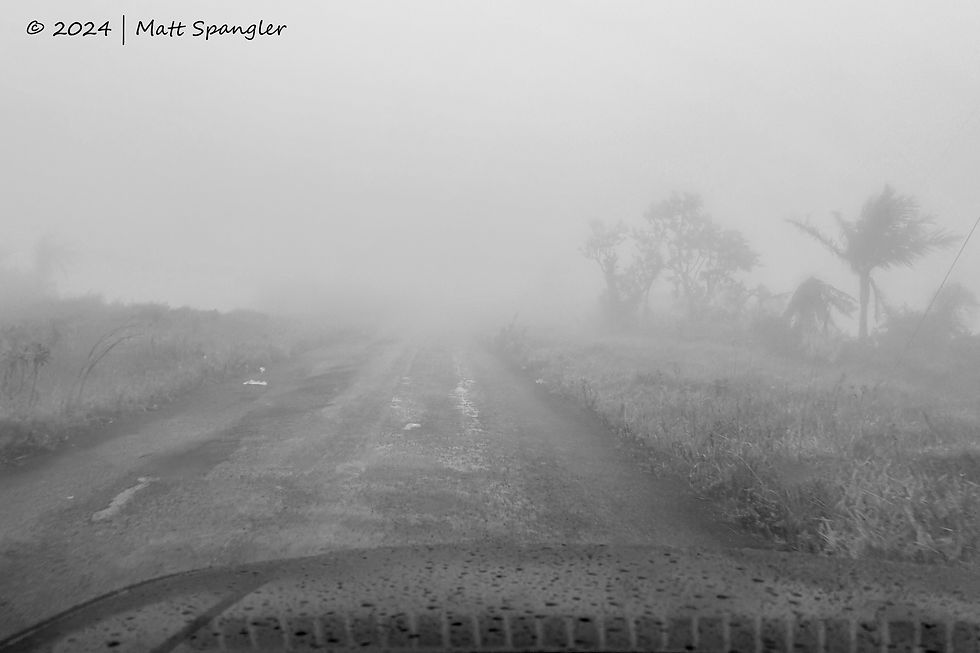
We reached our stopping point in the Toro Negro State Forest around lunchtime. Since most of our planned hike was on the leeward side of a mountain, we figured the fun would at least slightly outweigh the miserable conditions. After winding our way up a rough road, we eventually ascended Puerto Rico’s tallest point: Cerro de Punta, at 4,390 feet above sea level. It’s said that you can see nearly the entire island, coast to coast, from the top. We couldn’t even see the top of the nearest cell tower!
The conditions were about as bad as they can be for birding: howling winds and the midday siesta hour kept the birds hunkered down and out of earshot, and the fog made visual observations next to impossible. Nonetheless, I’m pretty sure I heard the call of a (lifer) Bicknell’s Thrush, a rare and elusive bird most often found on its breeding territories in Vermont, New Hampshire, and Maine. This mountain is a known wintering site for the species, and (surprise!) one of the reasons I picked it for our stop.
After another hour or so of driving, we wound our way west and then north towards Utuado and Arecibo. The solid mountains eventually fractured into a dramatic series of undulating limestone hills and cliffs. The karst topography in the northern part of the island really blew my mind, but it was hard to capture with photos. Our road ended at our next Airbnb (“Finca Regina”), nestled along the shore of Lago Dos Bocas, a reservoir filling twin river valleys. The sun emerged for our arrival, exposing a truly glorious vista. The hills were steeper, the vegetation lusher, and the human presence less obvious the rural setting in Barranquitas (unless you count the lake and dam, of course). Our Airbnb really capitalized on the view, with windows everywhere and a waterfront dock.
Wildlife was abundant along the lakeshore. Brown Pelicans regularly crashed into the water, putting on a fishing show that I’m not accustomed to seeing on freshwater lakes. I saw a Black-whiskered Vireo (much more satisfying than my heard-only lifer earlier in the AM), and had a good photo-sesh with a few Bananaquits. It’s always nice when the most common bird is also charismatic and attractive!
I also picked up two lifer herps—the Puerto Rican Slider and Puerto Rican Ameiva—plus a handful of anoles and a Green Iguana practicing its long-distance swimming. I also added lifer to my lep list (Antillean Mapwing) and also to my list of gastropods (Granodromus lima, a snail endemic to Puerto Rico).
The nice weather convinced me to make one last excursion for the day, to the Río Abajo State Forest. It was only an 18 minute drive from our house, and it’s one of the last two places place on Planet Earth where one can see the critically endangered Puerto Rican Parrot (the other is El Yunque National Forest). Due largely to habitat loss, the population of this species declined to just 13 individuals in the 1970s. A captive breeding program has increased their numbers to several hundred, a relatively small portion of which live in the wild. Many of the wild parrots remain relatively close to the breeding facility in Río Abajo. So, that’s where I went to look, and that’s where I found them. About ¼ mile from the breeding center, I heard some parrot-like squawks and looked up to see a group of … humans, all staring intently into the trees. Then a parrot flew across the road, and then another, and eventually we all got good looks at about a dozen parrots flying around and foraging in the treetops. It was a great experience, and easier than I thought it would be. I hope that with time, it will become even easier to see this spectacular Puerto Rican endemic (# 6 for me), but I fear that won’t be the case.
The rest of the birding at Río Abajo was anything but easy. The vegetation is so dense and jungle-like that it was hard to see birds, and my knowledge of Puerto Rican birdsong was still pretty poor at this point in the trip. So, there were lots of heard-only, unidentified birds. But in addition to the parrots, I saw two other lifers, both endemics: Puerto Rican Vireo (endemic # 7) and Puerto Rican Tody (endemic # 8, more on that one later), plus my first visual confirmation of a Puerto Rican Bullfinch. It was also nice to see the endangered Puerto Rican subspecies of Broad-winged Hawk, who had just captured some type of smaller bird. I also saw two new butterflies at the forest: a V-mark (aka Vitellius) Skipper and Caribbean Swallowtail.
After a relaxing evening at home—complemented as usual by a singing Puerto Rican Owl—we called it an early night.
Tuesday
Tuesday was our only full day on Lago Dos Bocas, and rainy weather made for a relaxing day, with one exception. Unsurprisingly, I began with a bird walk down the country road to the dam and back. I picked up four more lifers: Venezuelan Troupial (a nonnative but very attractive species); Mangrove Cuckoo (great looks), Green Mango (endemic # 9; distant looks); and Cave Swallow (distant looks). The birding at the dam was also good, despite some rain showers. I didn’t see anything new, but I got much better looks at Cave Swallows, Caribbean Martins, Cabot’s Sandwich Terns, and lots of other species. The view of the Rio Grande de Arecibo from the dam was impressive.
But the real highlight of the dam was the mammals. Puerto Rico doesn’t have any native mammals other than bats (there used to be some, but they’re all extinct). But they do have a sizeable population of introduced mammals—mostly dogs and cats, some of which are feral and unfriendly. One of these damn dogs attacked and bit my calf as I walked by the dam. It bled a little and felt like I got punched for a couple days, but I was able to lope the mile-long walk back home without any issues. That’s the first time (and hopefully the last) I’ve been attacked by a dog. And if you couldn’t guess, it was the one exception to this being a relaxing day.
I made one other trip out of the house around midday, driving into town (Utuado) to pick up lunch and beer (Medalla Light, of course). Once downtown, I stopped on the side of the road to look at pigeons and doves on the power lines, of course. Among the Rock Pigeons and Eurasian Collared-Doves was an African Collared-Dove, an out-of-place lifer.
My wife and I and spent the rainy afternoon and evening lounging around the Airbnb, enjoying the unbeatable scenery from the covered porch. A procession of wildlife continued throughout the day, including a few new characters: Puerto Rican Lizard-Cuckoo (brief looks but good listens at endemic # 10), Puerto Rican Mango (distant looks), and a group of Bronze Mannikins (transplants from Africa). But the real fun was photographing a Puerto Rican Tody, who made a couple of appearances in the yard. Familial consensus is that this tiny songbird is the coolest bird on the island.
The standard assortment of reptiles (seen the day before) made appearances throughout the day, and I added a new fish to my life list: the Midas Cichlid (a nonnative species).
Later that night, a Puerto Rican Owl made its fourth consecutive appearance.
Wednesday
Wednesday was another transition day, but it started like most others. My wife relaxed while I went out on a short adventure, this time to a different section of the Rio Abajo State Forest. The main bird highlight was one more lifer, a distant Lesser Antillean Pewee (aka the Puerto Rican Pewee, sometimes considered a separate, endemic species).
My primary targets this morning weren’t actually birds, but rather bats. I hiked/climbed/crawled up a barely discernible cut in the forest to the mouth of a cave about 50 feet above the trail below. The open-air vestibule of the cave featured interesting mineral formations and a stellar birds-eye view of the surrounding forest.
But the cave proper was something else. This was a place for (lifer) Jamaican Fruit-eating Bats, not humans. Wild places like this are a refreshing reset from the tendency to view the world as a place designed for (or by) humans. After sharing a few minutes (and photos) with the cave's inhabitants, I headed off.
With a little time to spare, I made one more quick stop at the Lago Dos Bocas “overlook.” An overgrown paved path spirals to the top of a conical karst formation, offering panoramic views of the lake and surrounding mountains. Well, it would have, if it had been maintained. It was totally overgrown, so the best I could do was peek through the vegetation, viewing our Airbnb from across the lake. The short stop wasn’t a total loss: I got great looks at two more lifers, both endemic to the island: Puerto Rican Euphonia (endemic # 11) and Adelaide’s Warbler (endemic # 12). I also got up-close looks at a Puerto Rican Vireo and a Puerto Rican Lizard-Cuckoo—a much more satisfying experience than my sightings day before.
We checked out soon after I returned. The road to San Juan meandered around, between, and occasionally through the bizarre but majestic karst landscape. The rain picked back up by the time we got to the city, but we still enjoyed a nice lunch and a rainy town-and-beach-walk around Condado. The human highlight was a spectacular mural, complete with a beautiful naked woman, an even more beautiful but less naked woman, and our favorite Puerto Rican bird. Wildlife highlights included a couple Tetro Sphinx moths: a colorful caterpillar and an enormous adult that I rescued from the tide line.
After dropping my wife off at the airport, I began phase three of the trip: my solo birding/ exploring adventure. I headed south from San Juan and wound my way back through the mountains. My first stop was Borinquen, a small town near Caguas. I stopped here to look for a pigeon. Not just any pigeon, but the Plain Pigeon. That’s right—as soon as my life left town, I went out of my way to look for a bird that is literally called “Plain Pigeon.” Although I covered a lot of ground along the Rio de Barranquitas and saw a whopping 5 different species of pigeons and doves, none were quite plain enough. It was still a nice leg-stretch, and I saw some other good birds (including the pictured Mangrove Cuckoo) and a small variety of reptiles.
Back on the road, I continued south through the light rain. The lush mountains and valleys of the northern and central regions eventually yielded to a very different landscape of hills with relatively stunted vegetation—the bosque seco (dry forest) of the south.

Eventually I neared the coast, where I made a quick stop at a random parking lot in Aguirre. The flowering bushes and trees in this area are a magnet for hummingbirds, and the drizzle did little to deter the voracious appetites of an Antillean Crested Hummingbird (lifer). While parked, I also had a group of Red-crowned Parrots fly over (an established exotic species, and another lifer).

After some westbound driving along the southern coast, I finally reached my home base for the next two nights: a modest condo in Playa Santa, near Guanica. A well-named Magnificent Frigatebird greeted me at check-in. After getting settled, I strolled around the nearly deserted coastal town in search of food, finding a single open restaurant: a food truck. Luckily the rain had abated, so I ate outside with the proprietor, who fried me up a delicious fresh-caught Red Snapper.
After dinner, I decided to squeeze in one more after-hours bird search. I drove to some offroad vehicle trails just outside of town and began a slow march, ears peeled. I managed to hear 3 Puerto Rican Nightjars (a lifer, and endemic # 13—found only in the dry southern hills), plus another Puerto Rican Owl (for the 5th night in a row). I also saw an enormous Caribbean Land Hermit Crab and an even more enormous (nonnative) Cane Toad, both new to me. And then at long last, I called it a day.
Thursday
Thursday was my big day for birding. So, get ready for a lot of text and a lot of photos.
I hit the road before dawn, drove west along the highway for an hour, then drove another 30 minutes north up insanely curvy mountain roads, stopping once to move a large rock out of the way. I arrived at the Maricao State Forest a bit after sunrise. The 2900’mountains tower over the surrounding coastal plain, offering distant views of the Caribbean. And although the forest was lush, the vegetation was generally shorter than at Río Abajo SF, which made it a lot easier to see birds. Of all the spots I visited during the week, this was my favorite site for viewing songbirds.
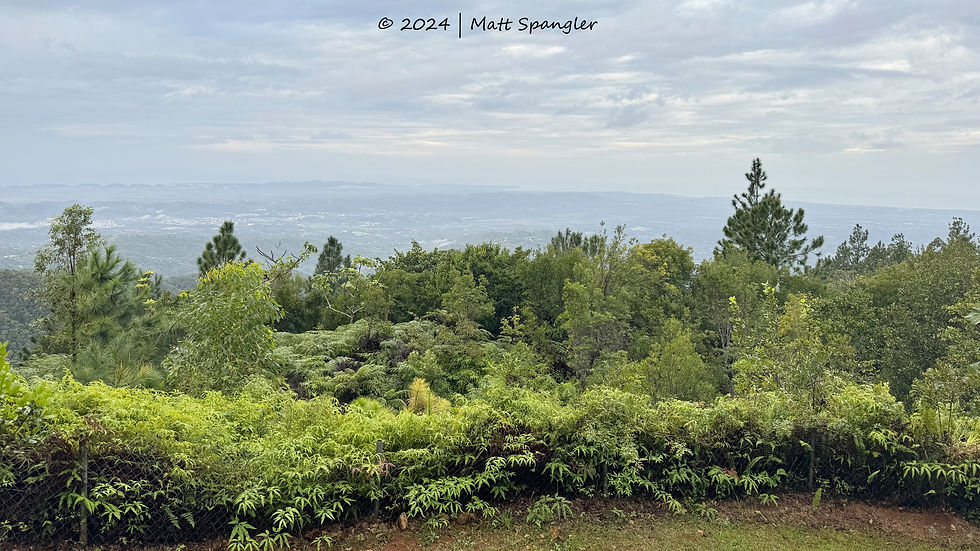
The first bird I saw—immediately after I stepped out of the car—was an Elfin Woods Warbler. This was endemic # 14 for me; it’s endemic not only to Puerto Rico, but to this single forest (populations in other forests on the island appear to have been wiped out). Even more, it’s the “newest” New World warbler in the world, first discovered in 1968 and described in 1972. During the hour and a half I spent at Maricao, I encountered at least 7 of these warblers (some seen, some heard). I also saw two other lifers: Puerto Rican Tanager (endemic # 15; they were extremely abundant here) and Puerto Rican Spindalis (endemic # 16; an apparently common bird, but the only one I saw on the entire trip). Although I only saw 16 species during my short walk through the forest, 8 were endemics—so, 8 of the 18 species that are found only on Puerto Rico. That’s what you call quality over quantity!
Next up was Laguna Cartagena National Wildlife Refuge. It’s my favorite type of place: a vast but accessible marsh, reminiscent of some I’ve visited in Florida. The wetland was loaded with some of my favorite species: Purple Gallinules, Common Gallinules, Soras, Least Bitterns, Glossy Ibises, etc. Of course, you can see all of those in the continental US. The Puerto Rican additions (lifers for me) included a distant group of West-Indian Whistling-Ducks and a tiny Yellow-breasted Crake that flushed from close range—perhaps the most exiting sighting of the trip. A spotting scope would’ve been helpful to ID more of the distant ducks.
The refuge is also home to a lot of non-marsh birds, and I picked up two more passerine lifers: the endemic Puerto Rican Flycatcher (endemic # 17—almost there!) and the exotic Northern Red Bishop. Cool non-lifers included Monk Parakeets, Smooth-billed Anis, a handsome male Puerto Rican Emerald, and a few warblers that I normally see in the NC summer.
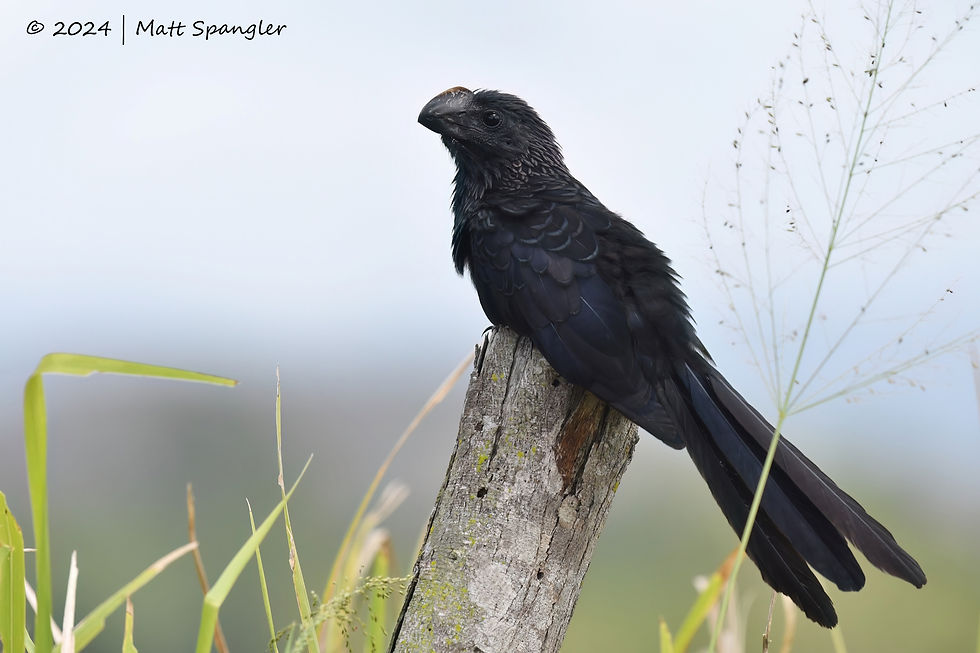
The refuge is also home to a lot of non-birds. Around noon, the sun came out—and it came out to stay, unlike the teasers earlier in the trip. It got downright hot, which was fine by me, as the heat finally brought out some invertebrates. Until then, I’d only seen a scattering of butterflies and almost no dragonflies. On my short, sunny walk back to the car, I saw at least 9 species of butterflies, including 3 lifers: Northern Tropical Buckeye, Hanno Blue, and Large Orange Sulphur. Hundreds of dragonflies were present; I identified 4 species, including 2 lifers: Tawny Pennant and Caribbean Dasher.
The cold-blooded vertebrates also enjoyed the sun. I saw Green Iguanas, lots of anoles (probably all Crested Anoles) and Puerto Rican Sliders, and heard a variety of (mostly unidentifiable) frogs.
Next was lunch; I grabbed a quick bite with some locals at a roadside joint. They bought me a beer, I bought them one, etc. The locals of rural Puerto Rico were all extremely accommodating and handled my broken Spanish with patience.
Coincidentally (I promise), lunch was right next to a neighborhood pond that had featured prominently in recent rare bird reports. Before I could even park my car, I saw a group of black birds flush from a resident’s yard. Jackpot! This was a group of Yellow-shouldered Blackbirds—an endangered species, a lifer, and Puerto Rican endemic # 18 of 18. Even better, an indescribably gracious couple invited me into their yard to get close looks at the blackbirds, which apparently frequent their sugar feeder (yeah, just straight up sugar on a feeder-mounted plate). I was super grateful. I wasn’t sure I’d see this species at all, much less get such an intimate encounter. It was a nice way to experience my final endemic bird species of Puerto Rico.
Between the yard and the nearby pond, this random neighborhood stop proved fruitful. I saw scores of White-cheeked Pintails (another lifer), various other ducks, a big group of Black-necked Stilts, more African Collared-Doves, another photogenic Puerto Rican Emerald, some Venezuelan Troupials, iguanas, sliders, etc
As productive as it was, the neighborhood was a pit stop en route to my primary destination: Cabo Rojo (the actual cape, not the town). Driving there was an experience: the last mile involved alternating between dirt, mud, and fairly deep water. It was worth it; the xeric, hilly landscape around the Los Morrillos lighthouse provided panoramic views of the surrounding mudflats, mangroves, shallows, and stark cliffs overlooking the Caribbean.
There weren’t many birds active in the glorious mid-day sun, but it was another quality-over-quantity deal. I saw a half dozen Brown Boobies hanging out on the cliffs! You read that right: after my wife left me to my own devices, I went looking for Plain Pigeons and Brown Boobies.
Also present around Cabo Rojo was a White-crowned Pigeon (only the second I’ve ever seen), a Magnificent Frigatebird, and some Common Ground Doves. The reptiles were also out in full force; I saw a dozen or more Puerto Rican Ameivas and nearly as many Green Iguanas. One iguana was perched atop a 100-foot rocky island, which was a bit of a puzzle. Why brave the battering seas near the cliffs just to sunbathe on a rock island with no food?
After a brief stop to photograph a Lesser Yellowlegs on the muddy drive out, I headed back to Playa Santa.
I kayaked across the Playa Santa bay over to Playa la Jungla, then spent the rest of the afternoon wandering around and hanging out. I hiked around a bit, enjoying great views of Adelaide’s Warblers and other species flitting around the low, scrubby vegetation characteristic of the southern coast.
I also bushwhacked over to two freshwater ponds. While there, I found a few things. First, birds: there was a nice assortment of shorebirds, including good numbers of Stilt Sandpipers and some photogenic Semipalmated Sandpipers. Second, bugs (well, biting flies, not true bugs, but you know what I mean). The entire trip had been surprisingly bug-free, but I finally found them. I stepped through thousands of mosquito larve and got bit by a few adults. But they weren’t the worst hazard—that prize goes to the inescapable tangle of thorns, which seemed to adorn every vine, tree, and (of course) cactus. I also almost lost a leg to an enormous Blue Land Crab, which dwarfed a nearby can of Medalla Light!
I eventually settled down to relax on what was effectively a private beach. On the sunset paddle back, I came across a live King Helmet Snail, my last wildlife sighting of the day.
I ate dinner a few hundred yards from my Airbnb, at a table in the middle of the street, surrounded by locals having what was apparently a run-of-the-mill Thursday night street party at the local empanadilla shop. That was a pretty fun way to end a long and active day.
Friday
I realized Thursday night that my flight home on Friday was several hours earlier than I’d expected. So, on my last day in Puerto Rico, I had to triage my limited free time. Do I try to check out a few new places? Do I relax and get a better feel for the dry forests around Playa Santa? Do I go back to somewhere else I’ve already been?
I ended up going with the latter two. I spent the pre-dawn hours walking the ORV roads just north of town. This time, I got much closer to a singing Puerto Rican Nightjar; this was a much better experience compared to the distant, faint sounds from two nights prior. I then drove back to the west end of Laguna Cartegena for a sunrise walk out into the marsh. I saw many of the same great species as yesterday’s visit, including distant looks at another Yellow-breasted Crake. But the early morning also proved better for some elusive species I hadn’t seen the day before: a rare Striated Heron (lifer) and over a dozen Masked Ducks (lifer).
A Limpkin, tons of Western Cattle Egrets, and the usual complement of songbirds provided additional interest. I also picked up a new damselfly: the West Indian Firetail.
That was pretty much all I had time for. I hit the road for another long day of driving, stopping twice: once to get better photographs at an Antillean Crested Hummingbird near Aguirre, and a second time for a carwash (which nearly erased the evidence of my Cabo Rojo adventure). I also photographed the ruins of an oil refinery near Peñuleas. It’s kind of random, but I think it makes for a nice photo, symbolizing the island’s interesting mix of nature, humanity, and infrastructure issues.
Then it was back to RDU aboard JetBlue. Adios Puerto Rico!

Summary by the Numbers
This week-long trip involved a good amount of travel: 2900 miles by plane, 584 miles by car (and 20 hours behind the wheel—yikes), 27.5 miles on foot, and 2 by kayak.
I saw lots of birds! Well, I observed 103 different species, 100 with visuals and 3 more heard-only. As previously mentioned, among the 103 were all 18 of Puerto Rico’s endemic species; given that this was my first trip to the island, all endemics were also lifers. 75 were native but also live elsewhere; 24 of those were lifers. Finally, 10 were introduced; 6 of those were lifers (it’s always a little funny to get your first sighting of a bird that isn’t in its native country). That’s a total of 48 lifers, bringing my life list to 631 species.
Other wildlife on the island included: 5 species of reptiles (4 lifers); at least 3 amphibians (2 lifers); 1 mammal (lifer); 1 fish (lifer); 15 leps (8 lifers); 6 odes (3 lifers); 4 gastropods (all lifers); and 2 crustaceans (both lifers).
I took 1996 photos (1600 on my camera; 396 on my phone); that’s typical for this type and length of trip. The best 220 made it to this blog.
Postscript
This was our first trip to Puerto Rico, and it was fairly immersive from both a natural and cultural perspective. So, similar to what I did at the end of my Scotland blog, I’m going to capture a few non-wildlife related thoughts about how Puerto Rico differs from America.
Overall, it wasn’t too different. It’s a United States territory, after all. Everyone in the populated areas spoke English, and the cities featured familiar food and retail chains.
However, we spent most of our time in rural, lower-income parts of the island, which was a bit less familiar. From a handful of interactions, I got the sense that a decent proportion of folks in these areas did not speak (much) English. This gave me an excuse to practice my Spanish (which I had tried to re-learn for the two months prior to the trip, with limited results). Everyone was really nice, and it always felt completely safe (except for the damn stray dogs!).
The island’s infrastructure seemed generally solid. The roads were reasonably well-maintained (think South Carolina), we had cell service almost everywhere, and the power and internet never cut out. But some places showed more signs of neglect, like public lands that were closed and had clearly not seen any human attention for a number of years.
The houses, though modest, all had their unique charms; they seemed to fit with the landscape, despite (or perhaps because of) their bright colors. All the houses seemed to be built of cinderblocks and concrete, and all had flat roofs. I guess that makes sense in a land where moisture and humidity are major factors, but snow is not.
Some of the most interesting differences (to me) involved driving. Some of the differences were good, others bad. The good: cars pull out into the road whenever they like, and everyone else slows down to let them. This might sound like a bad thing, but it seemed indicative of a broader cultural perspective: be nice, let everyone have their turn, and don’t be in such a rush. Once you learn to take advantage of the system, it’s a lot better and more fair than mainland America’s cutthroat, don’t-you-dare-cut-me-off system. The bad: people do not honor the “slower traffic keep right” concept on the highways, at all. Puerto Rico has the same signs as NC (well, in Spanish), but no one paid even the slightest attention to them. And I’m not talking about your standard left-lane-loitering that occasionally happens here. I’m talking about a systemic problem. People also don’t use turn signals very often. This turned the highways into an inefficient and potentially dangerous exercise in defensive (and sometimes offensive) driving. So, overall, Puerto Rico does slow-speed roads well, but high-speed roads poorly.
That’s all I have to say, for now. I’m looking forward to our next trip to the island.














































